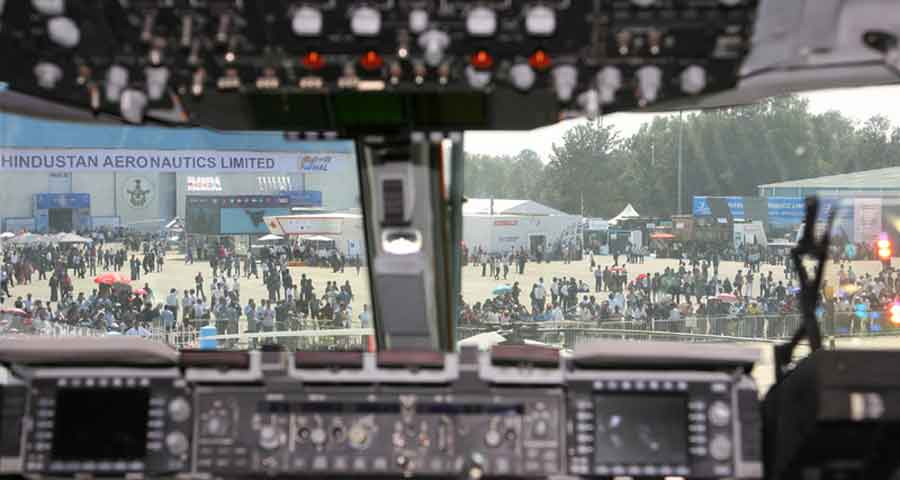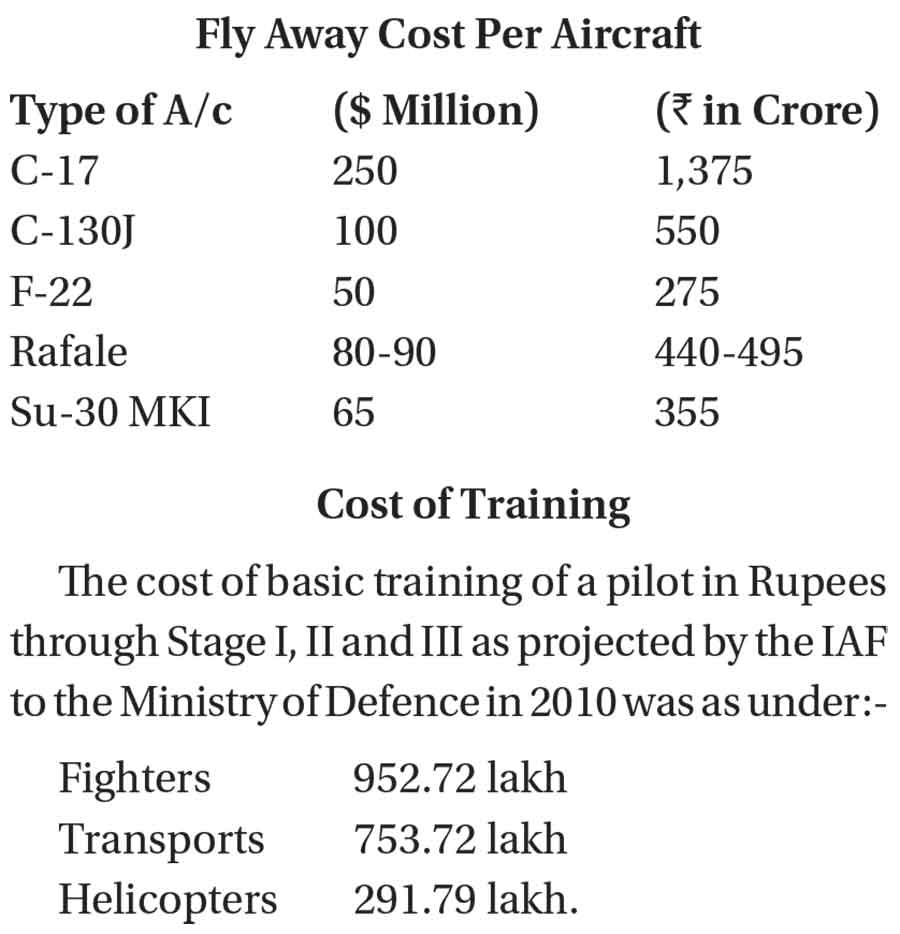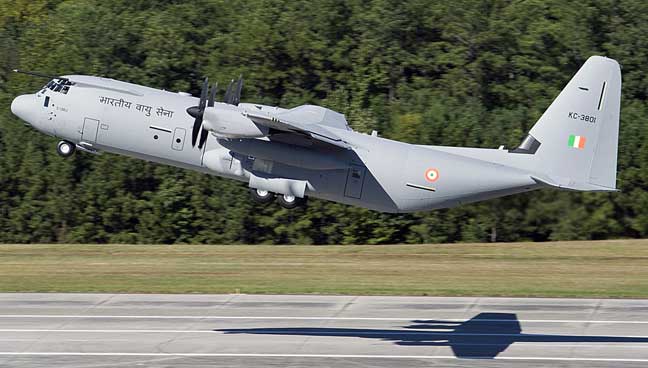“Simulators go a long way in ensuring that a pilot learns about systems under simulation before he actually uses these on-board an aircraft thus saving precious flying hours. Apart from simulators being inducted with the new aircraft being contracted for, the IAF has taken a conscious decision to include simulator training as part of the curriculum for ab initio training of pilots.”
—Air Chief Marshal NAK Browne, Chief of the Air Staff, Indian Air Force
“Simulation” implies an imitation of a real-life process usually with the help of a computer or other technological devices, in order to provide a life-like experience. This has proven to be a very reliable, successful and a low-cost option for training not just in the militaries worldwide, but even in the corporate world. It is important to emphasise that training simulation is not just a glorified video game but its aim is to train and educate to develop skills that would be used when faced with a similar situation in real life.
Simulators provide an opportunity to practice for even the most unforeseen contingency…
The rationale for providing simulators in the domain of military training is obvious. Given the rising costs and increasing complexities of aircraft and other weapon platforms, there is a requirement for infrastructure and resources to provide real life situations with a facility to record and analyse the performance of trainee. Simulators can bring realism to training where none exists, not just for the training of an individual but an entire team. The simulator is a special category of training device that can replicate all or most of the functions of a system. Simulators can, therefore, be used to train operators in various skills while preserving the primary equipment for operational use.
The association of the Indian Air Force (IAF) with simulators is not new. A rudimentary simulator known as a Link Trainer was in service many decades ago to introduce pilot trainees to instrument flying in the Intermediate Stage of training now termed as Stage II. It was equipped with air bellows to provide roll and pitch inputs and an electric motor which, while rotating the platform, provided the yaw cues. The cockpit was fully covered and the layout was generic. Apart from the Link Trainer, the pilot trainee was introduced to the Ejection Seat Simulator, which besides being used for medical evaluation, also provided a near realistic experience of ejection from an aircraft. On commissioning, when the young pilots moved to the Operational Conversion Unit, they had their first introduction to an aircraft simulator, the Hunter Simulator, which had the complete cockpit layout, could simulate a complete sortie profile and even provided sound effects.
Thereafter, pilots got the opportunity to train on the simulators of combat aircraft such as the MiG 21 or Su-7. Today, the IAF has graduated to the Hawk Simulator as also Flight Training Devices for the AN-32 and Do-228 in the basic training stages. Thereafter, pilots are exposed to other highly technologically sophisticated simulators such as for the C130J multi-engine transport aircraft. Apart from flying training the IAF has simulators for training of vehicle drivers, medical personnel, radar operators, basic and advanced training of Air Traffic Controllers (ATC) as also for war-gaming, weapons and combat training, to mention a few. Apart from simulators for training in the IAF, the Indian Navy has a Disaster Training simulator at its base in Lonavala. This simulates the flooding of a ship while experiencing severe pitching and rolling movements.
Flying training has always been an expensive proposition with both platforms and weapons becoming prohibitively expensive…
The Need
So why are Simulators important? The answer is ‘training’ of the man behind the machine. With the modernisation of the Armed Forces and the induction of ‘superior class’ of platforms and weapons where one can feed the coordinates of and engage the target in the operational area with a high degree of accuracy from the safety of location thousands of kilometres away and tracking the enemy on a TV screen. The man behind the machine is the actual war machine, driving tanks, manning ships or flying aircraft. He has, therefore, to be trained to be not only physically strong but also mentally sound with all-round training to be able to adapt to any situation that may arise in the course of operations.
The man behind the machine also needs to train to fight unseen enemies. While the nature of war may not have changed, the conduct of war has definitely undergone a transformation. Modern day simulators, with rapid developments in computer science, can paint near-real scenarios and much more. Simulators provide an opportunity to rehearse procedures for even the most unforeseen contingency, be it in flying or in other types of ground-based operations. It also provides the opportunity to train by day and night, irrespective of weather conditions.
Another advantage of the simulator is the cost factor. Flying training has always been an expensive proposition with platforms and weapons becoming prohibitively expensive. Flying an empty aircraft purely for training is a luxury that the IAF can no longer afford. The Russians have been known to comment adversely on the training of pilots by the IAF on the IL-76 aircraft that are flown empty for this purpose consuming eight tonnes of precious Aviation Turbine Fuel every hour. Aircraft are costly machines; even more costly to operate. Every time an aircraft takes to the skies, be it for an operational mission or a routine training sortie, there is the need for associated specialist equipment and technical manpower. This is apart from the large infrastructure requirement and deployment of personnel to man services such as Air Traffic Control, Safety Services and Radio Navigational aids. The man-hours involved, wear and tear on the equipment and consequently, cost can be reduced to a large extent if part of the training is shifted to simulators. This following table illustrates the exorbitant costs of aircraft and of training.
The advantage of simulators is that aircrew continue to gain valuable training at a fraction of the cost and without the risk of losing lives or machines. To cite an example, the newly acquired C-130J costs Rs 12 lakh per hour to operate, while the operation of its simulator costs only Rs 25,000 an hour. It is, therefore, an issue of doing more with less.
The advantage of simulators is that aircrew continue to gain valuable training at a fraction of the cost.
Present Status
The Kiran aircraft, presently being employed as the basic trainer for ab initio and Stage II training for the budding fighter pilots, is supported by a Pilot Procedure Platform (PPP) and a Cockpit Procedure Trainer (CPT), both poor cousins of a simulator. These are fixed platforms meant primarily for practising procedures. On the other hand, in Stage III, the training syllabus on the Hawk Advanced Jet Trainer is divided into two semesters. The schedule has simulator training embedded from the first semester itself and consists of 30 per cent of the training in assessed sorties. This simulator is far more sophisticated than that for the Kiran aircraft but is still not a full motion simulator; the ‘motion’ is provided on large screens through computer-generated videos which are realistic and permit full sortie profile to be simulated. For the training of transport pilots, the IAF has a Flight Training Device (FTD) one each for Do-228 and An-32 aircraft. These are somewhat similar to the Hawk Simulator but the sorties are not assessed as the quality of simulation is nowhere close providing realistic feel of flying.
The first full motion simulator that the IAF now has is that of C-130J. This is a high-fidelity, six-axis, full motion, electrically operated simulator that is capable of initial pilot training as well as operational training. With this induction, a new era in the use of simulators in the IAF has been ushered in with the entire training i.e. initial conversion, operational training, check sorties and continuation training being flown on the simulator. It has been set up at a cost of $46 million, just a shade less than half the cost of a new aircraft. The cost however, can only be recovered if the simulator is exploited to its maximum capacity and utilised for all exercises and role clearances, as is done in the US. For operational training on fighter aircraft, the IAF has mission simulators, but the numbers are limited. Consequently, operational training continues to be carried out through actual flying, a very costly proposition indeed. Delay in acquisition of additional simulators required may be attributed to the traditional mindset of hands-on flying training, high initial investment and lack of appreciation of the benefits of simulator training or a combination of all. The situation is however, changing for the better with new simulators on the anvil. Due importance is now being given to simulator training both in the initial training phases and for continuation training.
Case Study: C-130J Training
The training curriculum for training on the C130J is as under:-
Simulators can bring realism to training where none exists, not just for the training of an individual but an entire team…
- Conversion Training – 80 hours entirely on a full motion simulator.
- Mission Training for All Roles – 80 hours on simulator plus 25 hours of actual flying.
- Overall – 160 hours of simulator training plus only 25 hours of actual flying.
The end product is a fully operational pilot cleared on all tactical roles of the aircraft in six months with minimal flying on the aircraft.
The C-130J simulator at Little Rock, USA, runs 20 hours a day from 0600 to 0200 hours the next day. Four hours of maintenance is planned from 0200 to 0600 hours. The simulator is operational five days a week and runs for at least 400 hours a month. This is also the manner in which commercial airlines utilise their simulators. Simulators are housed in air conditioned environment and can operate continuously without any requirement of cooling time. Hence, the longer the simulator is kept running, the better the utilisation. Typically, the syllabus on the simulator for under-training pilots is undertaken by two ‘simulator partners’ who are paired for the full conversion/ training period. A pair of trainees flies two hours each, from the right and left seat during a four-hour session. Hence, five batches i.e. ideally, ten pilots occupy the simulator in an operating cycle of 20 hours. The other batch on the off day, undertakes ground training. This is the best way to recover the investment on the simulator.
Requirements
In order to maintain an edge operationally, there is a requirement to provide high-end military flight simulators for flying training. Simulators must have high fidelity, large Field-of-View (FoV) image generation, large visual data-base of terrain that the IAF operates in and high resolution displays apart from being energy efficient and capable of long hours of operations. To say the least, the simulators should be available for a minimum of eight hours daily for five days a week, for 48 weeks a year, i.e. 1,920 hours annually, maintaining an average serviceability of at least 92 per cent.
The Indian Armed Forces is today technology-intensive and uses highly sophisticated equipment.
Flying missions in the military are different from those in civil aviation. Special skills are required to fly in varied configurations and over inhospitable terrain at tree-top levels. Training, therefore, needs to be appropriately tailored. In addition to flying per se, military simulators require mission training capabilities such as targeting, gunnery, practice bombing and simulation of the Electronic Warfare. There is also a requirement to simulate a ‘package’ of the aircraft, as would be required for a particular type of mission. These requirements would be more or less common to any type of military aircraft, be it a trainer, fighter, transport aircraft or helicopters. Military simulators for large transport aircraft need motion platforms for cues of real movement.
Simulator training is applicable not only to the IAF but also to the civil aviation sector. Currently, there are about 1,280 Full Flight Simulators (FFS) in operation worldwide certified for pilot training in the Commercial Air Transport (CAT) sector by the relevant National Civil Aviation Regulatory Authorities. Out of these, about 550 are in the US, 75 in the UK, 60 in China, 50 each in Germany and Japan and 40 in France. In India, the numbers can be counted on one’s finger tips. Clearly, much needs to be done on this front.
Other Simulation Requirements
The Indian Armed Forces today are technology-intensive and uses highly sophisticated equipment. Other than aircraft simulators, there is a large requirement for Computer Based Training (CBT) and working models with the need to move to simulation, away from the old cut or exploded models. Simulators for Remotely Piloted Vehicles, ATC, vehicle operators and weapon handling are required in adequate numbers at the training institutes.
In India, the numbers of simulators can be counted on fingers tips.
Another military-specific requirement is war-game simulation. Full-scale military exercises or even on smaller scale, are not always feasible or even desirable. Apart from availability of resources, men, material and money in the present world order, the complexity of contingencies and hence the need for simulations has increased. Modern information gathering technology provides the Commander with a plethora of information from various sources that renders decision-making difficult. There is an ever-increasing requirement, therefore, to carry out these exercises, more as command and information exercises with software to generate the accurate forecasting of results. Inroads have been made by the Armed Forces on their own, but many factors affect success of these programmes and their timely completion, thus leading to cost and time overruns as also technology obsolescence. These programmes need to use evolving technology development in software with the strong IT base that India has.
Outsourcing and Private Partnership
The model followed by the RAF needs a mention. Thales UK is not only a supplier of crucial military technology but also works in close collaboration with the UK MoD to provide training on Lynx Mk-7 and Mk-9 helicopters. The Company also undertakes training for Tucano, Tornado, Jaguar, Tristar, VC-10, C-130 and Sea King. Similar examples are available in other parts of the world. The strong IT industry in India provides the potential for India be a hub for production and operation of simulators, for both domestic and global markets. In Bengaluru itself there are many companies that are associated with simulation technology to whom work-packages can be outsourced. The IAF and the Industry need to get into long term partnership.
The IAF and the Industry need to get into long term partnership.
Conclusion
Training is a command responsibility. Air warriors need to be trained to be proficient on the platforms and weapon systems that they would be required to operate. They need to be trained to operate singly, as a part of a crew, as part of a small team or at the command level. The fundamental of peacetime training is to reproduce near real-time operational conditions so as to prove the modified adage, “The more you train in peace, the less you bleed in war.”
To be stating the obvious:
- Simulation solutions are needed. No part of the training can exclude the use of these devices to improve training efficiency and to reduce the ever-increasing cost.
- Aircraft simulators have reached a stage where they can be substituted to a large extent for training on actual aircraft.
- The IAF needs to acquire present generation simulators for it to meet the training challenges, to cut training costs and to improve efficiency.
- In order to obtain the best results, war-game simulations require present day and futuristic technology to be integrated.
- All this offers lucrative opportunities for the industry, a long-term industry-defence participation will be a win-win situation for both.








i want to do flight simulation course what is the charges and qualification requies please send me email or call me at 9930154940